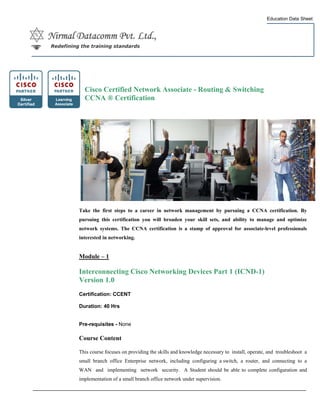Cisco Certified Network Associate New
- 1. Education Data Sheet Redefining the training standards Cisco Certified Network Associate - Routing & Switching CCNA ┬« Certification Take the first steps to a career in network management by pursuing a CCNA certification. By pursuing this certification you will broaden your skill sets, and ability to manage and optimize network systems. The CCNA certification is a stamp of approval for associate-level professionals interested in networking. Module ŌĆō 1 Interconnecting Cisco Networking Devices Part 1 (ICND-1) Version 1.0 Certification: CCENT Duration: 40 Hrs Pre-requisites - None Course Content This course focuses on providing the skills and knowledge necessary to install, operate, and troubleshoot a small branch office Enterprise network, including configuring a switch, a router, and connecting to a WAN and implementing network security. A Student should be able to complete configuration and implementation of a small branch office network under supervision.
- 2. Education Data Sheet Redefining the training standards Course Objectives After completing this course the student should be able to: ŌĆó Describe how networks function, identifying major components, function of network components and the Open System Interconnection (OSI) reference model. ŌĆó Using the host-to-host packet delivery process, describe issues related to increasing traffic on an Ethernet LAN and identify switched LAN technology solutions to Ethernet networking issues. ŌĆó Describes the reasons for extending the reach of a LAN and the methods that can be used with a focus on RF wireless access. ŌĆó Describes the reasons for connecting networks with routers and how routed networks transmit data through networks using TCP / IP. ŌĆó Describe the function of Wide Area Networks (WANs), the major devices of WANs, and configure PPP encapsulation, static and dynamic routing, PAT and RIP routing. ŌĆó Use the command-line interface to discover neighbors on the network and managing the routers startup and configuration Course Outline Module 1 - Building a Simple Network Module 2 - Ethernet Local Area Networks Module 3 - Wireless Local Area Networks Module 4 - Exploring the Functions of Routing Module 5 - Wide Area Networks Module ŌĆō 2 Interconnecting Cisco Networking Devices Part 2 (ICND-2) Version 1.0 Certification: CCNA (640-802) Duration: 40 Hrs Pre-requisites - ICND-1 Course Content This course focuses on providing the skills and knowledge necessary to install, operate, and troubleshoot a small to medium-size branch office Enterprise network, including configuring several switches and routers, connecting to a WAN and implementing network security.
- 3. Education Data Sheet Redefining the training standards Course Objectives After completing this course the student should be able to: ŌĆó Review how to configure and troubleshoot a small network. ŌĆó Expand the switched network from a small LAN to a medium-sized LAN with multiple switches, supporting VLANs, trunking, and spanning tree. ŌĆó Describe routing concepts as they apply to a medium-sized network and discuss considerations when implementing routing on the network. ŌĆó Configure, verify, and troubleshoot OSPF. ŌĆó Configure, verify, and troubleshoot EIGRP. ŌĆó Determine how to apply ACLs based on network requirements, and to configure,verify, and troubleshoot ACLs on a medium-sized network. ŌĆó Describe when to use NAT or PAT on a medium-sized network, and configure NAT or PAT on routers. ŌĆó Identify and implement the appropriate WAN technology based on network requirements Course Outline Module 1 - Small Network Implementation Module 2 - Medium-Sized Switched Network Construction Module 3 - Medium-Sized Routed Network Construction Module 4 - Single Area OSPF Implementation Module 5 - EIGRP Implementation Module 6 - Access Control Lists Module 7 - Address Space Management Module 8 - LAN Extension into a WAN
- 4. Education Data Sheet Redefining the training standards NDPL CCNA official Lab Topology Prem Estate, ŌĆśCŌĆÖ Wing, 3rd Floor, Sant Savata Cross Road No. 1 Mustafa Bazar, Bycuklla ŌĆō East, Mumbai 400010. Phone: 022-23788200




